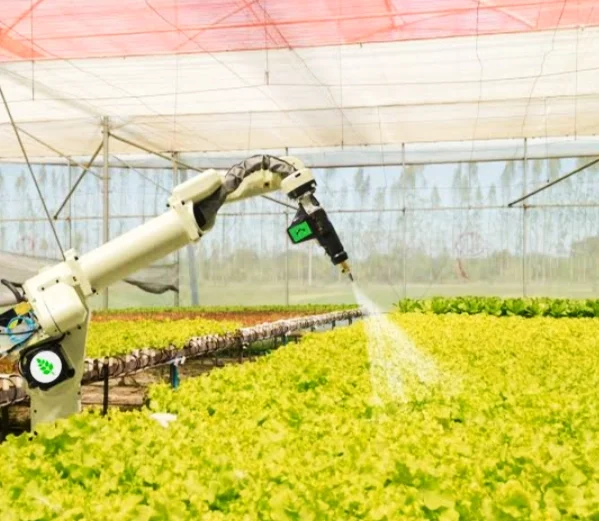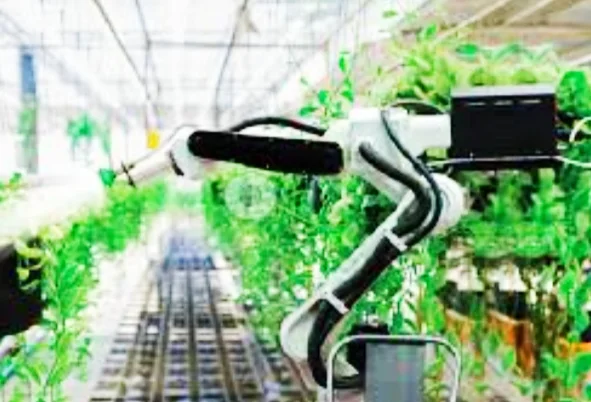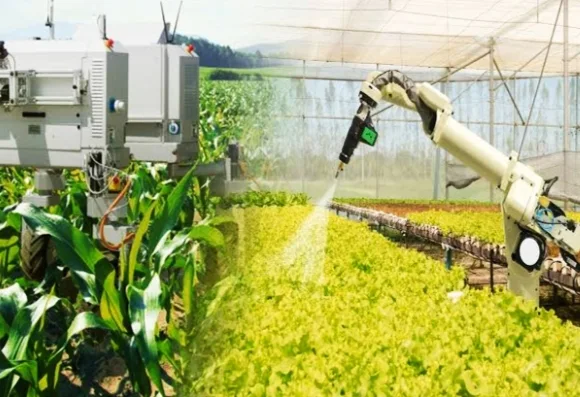The Rise of the Agricultural Robots: How Robotics is Revolutionizing Agriculture
Agriculture is on the cusp of a technological revolution. Tractors have long been a mainstay of farms, but now a new breed of helper is entering the fields: robots. Agricultural robots, or agrobots, are transforming every aspect of farming, from planting seeds to harvesting crops.
Types of Agricultural Robots
Here's a table outlining some of the common types of agricultural robots and their applications:
| Type of Robot | Application | Description |
|---|---|---|
| Seeding Robots | Planting | These robots precisely plant seeds at controlled depths and distances, optimizing seed usage and ensuring even crop growth. |
| Weeding Robots | Weed Control | Equipped with computer vision or laser technology, these robots identify and remove weeds while leaving crops unharmed. This reduces reliance on herbicides. |
| Scouting Robots | Monitoring | These robots navigate fields, collecting data on soil conditions, crop health (through visual inspection), and moisture levels using various sensors. This data helps farmers make informed decisions. |
| Harvesting Robots | Harvesting | These robots are being developed to carefully pick specific fruits and vegetables, minimizing damage and reducing post-harvest waste. |
| Milking Robots | Milking | Automated milking systems use robotic arms to milk cows efficiently and hygienically, reducing labor needs. |
| Livestock Management Robots | Livestock Management | These robots can herd animals, monitor their health, and even deliver feed, improving farm management. |
| Drones (Aerial Robots) | Field Mapping, Spraying | Drones equipped with cameras and sensors can map fields, identify problem areas, and precisely apply pesticides or fertilizers, reducing waste. |
From Planting to Picking: A Robot for Every Task
Agrobots are no longer science fiction. Today, a variety of robots are being used in fields around the world. These machines can handle a surprising range of tasks, including:
- Planting: Planting robots can precisely sow seeds at optimal depths and distances, ensuring more efficient use of seeds and fertilizer.
- Weeding: Weed identification and removal is a tedious task that robots can handle with greater accuracy and speed than human workers. This reduces reliance on herbicides and promotes a more sustainable farming approach.
- Monitoring: Equipped with sensors, robots can roam fields, collecting data on soil conditions, crop health, and moisture levels. This real-time information allows farmers to make informed decisions about irrigation, fertilization, and pest control.
- Harvesting: One of the most exciting applications of agrobots is harvesting. Robots are being developed to carefully pick delicate fruits and vegetables, reducing damage and waste.
The Benefits of Bringing in the Bots
The adoption of robotics in agriculture offers a multitude of benefits, including:
- Increased Efficiency: Robots can work tirelessly, completing tasks faster and more consistently than human labor. This allows farmers to cultivate more land and produce higher yields.
- Improved Quality: Robots can handle delicate crops with greater care, reducing bruising and damage during harvesting. This leads to higher quality produce for consumers.
- Reduced Labor Costs: While there is an initial investment in purchasing robots, they can help farms reduce their reliance on manual labor, a sector facing ongoing challenges.
- Sustainability: Robots can play a role in promoting more sustainable farming practices. Precision planting and weed control minimize waste, while data-driven decisions on irrigation and fertilization conserve resources.
The Future of Farming is Here
Robotics is still a developing field in agriculture, but its potential is undeniable. As technology continues to advance, we can expect to see even more sophisticated and versatile agrobots emerge. These machines have the potential to address the challenges facing agriculture, such as labor shortages, climate change, and the ever-growing demand for food. The future of farming is here, and it looks increasingly robotiic.
The Advantages of Having Robot Farmers: Benefits of Agricultural Robots
The integration of robots into agriculture offers a range of exciting advantages, transforming how we cultivate and manage our food supply. Here's a breakdown of some key benefits:
Benefits of Agricultural Robots
| Benefit | Description |
|---|---|
| Increased Efficiency & Productivity | Robots work tirelessly, completing tasks faster and enabling cultivation of more land for higher yields. |
| Improved Crop Quality | Robots handle delicate crops with greater care, reducing damage during harvesting and leading to higher quality produce. |
| Reduced Labor Costs | Robots decrease reliance on manual labor, addressing challenges faced by the agricultural workforce. |
| Sustainability & Environmental Benefits | Techniques like precision planting and data-driven resource management minimize waste and conserve water and nutrients. |
| Improved Worker Safety | Robots take over physically demanding or hazardous tasks, reducing injuries and illnesses among farmworkers. |
| Data-Driven Decision Making | Robots provide real-time data on various farm aspects, empowering informed decisions for optimizing processes. |
| Greater Flexibility & Scalability | Programmable robots adapt to various tasks, field sizes, and crop types, allowing for efficient scaling of farm operations. |
-
Increased Efficiency and Productivity: Robots are tireless workers, capable of operating for extended periods without breaks. This translates to faster completion of tasks and the potential to cultivate more land, leading to higher overall yields.
-
Improved Crop Quality: Agricultural robots can handle delicate crops with greater precision and care compared to manual labor. This reduces bruising and damage during tasks like harvesting, resulting in higher quality produce for consumers.
-
Reduced Labor Costs: While there's an initial investment in acquiring robots, they can significantly reduce a farm's reliance on manual labor. This is particularly beneficial considering the ongoing challenges faced by the agricultural workforce.
-
Sustainability and Environmental Benefits: Robots can play a significant role in promoting environmentally friendly farming practices. Techniques like precision planting and targeted weed control minimize waste of resources like seeds and herbicides. Additionally, data-driven decisions on irrigation and fertilization based on robot-collected information can conserve water and nutrients.
-
Improved Safety for Workers: Many agricultural tasks involve repetitive motions or exposure to harsh chemicals. Robots can take over these physically demanding or hazardous jobs, reducing the risk of injuries and illnesses among farmworkers.
-
Data-Driven Decision Making: Robots equipped with sensors can gather real-time data on various aspects of the farm's ecosystem, including soil conditions, crop health, and moisture levels. This empowers farmers to make informed decisions on resource allocation, optimizing processes and maximizing yields.
-
Greater Flexibility and Scalability: Agricultural robots can be programmed for various tasks and adapted to different field sizes and crop types. This flexibility allows farms to scale their operations more efficiently and adapt to changing demands.
The Global Race for Robot Farmers: Leaders in Agricultural Robotics Innovation
The agricultural landscape is undergoing a robotic revolution. While many countries are jumping on board, a select few are leading the charge in innovation. Here's a breakdown of some of the frontrunners in the exciting world of agricultural robots:
Agricultural Robotics Products by Leading Countries
Here's a breakdown of some key agricultural robot products being developed in leading countries, along with the companies behind them:
| Country | Company | Products |
|---|---|---|
| China | Evergrande Agricultural Robot Group | Planting robots, Weeding robots, Harvesting robots |
| China | XAG | Agricultural drones (spraying, field mapping) |
| United States | Blue River Technology | Intelligent weed removal robots (computer vision) |
| United States | Dearborn Motors | Self-driving tractors (precise planting, cultivation) |
| Germany | Fendt | Autonomous tractors (advanced navigation, obstacle detection) |
| Germany | Bosch | Sensor technologies, Robotic milking systems, Livestock management robots |
| Japan | Yanmar | Robotic rice planters, Robotic harvesting systems |
| Japan | Kubota | Autonomous tractors, Agricultural drones |
| Netherlands | Lighthouse | Indoor farming robots (planting, tending, harvesting) |
| Netherlands | DroneSeed | Drones for precise seed planting in greenhouses |
-
China: Backed by strong government support and a massive domestic market, China is a powerhouse in automation and artificial intelligence. Companies like Evergrande Agricultural Robot Group are developing a comprehensive range of robots for planting, weeding, and harvesting. Additionally, XAG has become a leader in the production of agricultural drones for spraying and field mapping.
-
United States: With its robust research and development infrastructure and significant private sector investment, the US is another key player. Blue River Technology is making waves with intelligent weed removal robots that utilize computer vision. Dearborn Motors is pushing the boundaries with self-driving tractors designed for precise planting and cultivation.
-
Germany: Renowned for its engineering prowess, Germany is a natural leader in precision agriculture. Fendt is a pioneer in autonomous tractors, equipping them with advanced navigation and obstacle detection capabilities. Bosch is a major contributor in sensor technologies and developing robotic solutions for milking and overall livestock management.
-
Japan: Faced with an aging agricultural workforce, Japan places high importance on labor-saving technologies and automation. Yanmar is a frontrunner in creating robotic rice planters and harvesting systems. Kubota is another major player, developing autonomous tractors and agricultural drones.
-
Netherlands: A global leader in greenhouse automation and vertical farming, the Netherlands is at the forefront of indoor agricultural robotics. Lighthouse creates robots specifically designed for planting, tending to crops, and harvesting within greenhouses. DroneSeed tackles the challenge of precise seed planting in these controlled environments with their innovative drone technology.
This is just a glimpse into the exciting world of agricultural robotics. It's important to remember that this is not an exhaustive list, and other countries are actively contributing to advancements in the field. Collaboration and knowledge sharing between these leading innovators hold immense potential to accelerate the development of even more sophisticated robots, shaping the future of agriculture.
The Frontrunners: Key Players in Agricultural Robotics Innovation
The agricultural industry is on the cusp of a revolution, driven by the rise of intelligent machines. While numerous companies are vying for a place in this burgeoning field, a select few have emerged as true leaders, shaping the future of farming with their innovative robotic solutions.
Key Player Products in Agricultural Robotics
Here's a table outlining the key products offered by some of the leading companies in agricultural robotics:
| Company (Country) | Products |
|---|---|
| XAG (China) | Agricultural drones (spraying, fertilizing, weed control, field mapping, data collection) |
| Evergrande Agricultural Robot Group (China) | Planting robots, Weeding robots, Harvesting robots |
| Blue River Technology (United States) | Intelligent weed removal robots (computer vision) |
| Dearborn Motors (United States) | Self-driving tractors (precise planting, cultivation) |
| Fendt (Germany) | Autonomous tractors (advanced navigation, obstacle detection) |
| Bosch (Germany) | Sensor technologies, Robotic milking systems |
-
XAG (China): Soaring to the top of the drone game, XAG has become synonymous with agricultural drones. Their unmanned aerial vehicles (UAVs) are a familiar sight in fields around the world, tasked with spraying pesticides, fertilizers, and herbicides with precision. XAG drones also play a crucial role in field mapping and data collection, providing valuable insights to farmers.
-
Evergrande Agricultural Robot Group (China): Taking a holistic approach, Evergrande isn't just focused on a single niche. This Chinese group is a major force, developing robots for various stages of the agricultural process. From planting robots that ensure optimal seed depth and distribution to weeding robots that tackle unwanted vegetation with accuracy, and even harvesting robots designed for delicate crop handling, Evergrande offers a comprehensive suite of robotic solutions.
-
Blue River Technology (United States): Waging war on weeds with intelligence, Blue River Technology is a US-based company that has revolutionized weed control. Their innovative robots are equipped with computer vision technology, allowing them to precisely identify and eliminate weeds while leaving crops unharmed. This targeted approach has the potential to significantly reduce reliance on herbicides, promoting a more sustainable agricultural approach.
-
Dearborn Motors (United States): Pushing the boundaries of automation, Dearborn Motors is a US company that's making waves with their self-driving tractors. These autonomous machines offer a high degree of precision during planting and cultivation, potentially leading to increased yields and improved resource efficiency. Dearborn Motors' technology represents a significant step towards a future where farms are run with minimal human intervention.
-
Fendt (Germany): German engineering prowess shines through in Fendt's autonomous tractors. These high-tech machines are equipped with advanced features like navigation and obstacle detection, allowing them to operate independently within fields. Fendt's focus on precision positions them as a key player in the agricultural robotics landscape.
-
Bosch (Germany): While Bosch may not be solely dedicated to agriculture, their contributions to the field are undeniable. Their expertise in sensor technologies has led to the development of innovative solutions for the agricultural sector. Additionally, Bosch's involvement in robotic milking systems strengthens their position in the broader agricultural robotics landscape.
It's important to remember that this is just a glimpse into the exciting world of agricultural robotics. Numerous other companies are making significant strides in this rapidly evolving field. As these leaders continue to innovate and collaborate, we can expect even more sophisticated robots to emerge, transforming the agricultural sector and shaping a future where our food is cultivated with greater efficiency, sustainability, and precision.
The Rise of the Agricultural Robots: A Future Planted in Automation
The agricultural landscape is undergoing a significant transformation. The backbreaking labor and time-consuming tasks that have long defined farming are slowly being replaced by the whirring gears and precise movements of robots. This rise of agricultural robots promises to revolutionize the way we cultivate our food, bringing a wave of efficiency, sustainability, and innovation to the fields.
A Bounty of Benefits
The integration of robots into agriculture offers a multitude of advantages. These tireless machines can work tirelessly, completing tasks faster and more consistently than human labor. This translates to increased yields, allowing farms to produce more food on less land. Additionally, robots can handle delicate crops with greater care, reducing bruising and damage during harvesting, ultimately leading to higher quality produce for consumers.
Beyond efficiency and quality, agricultural robots offer a path towards a more sustainable future for farming. Techniques like precision planting and targeted weed control minimize waste of resources like seeds and herbicides. Data-driven decisions on irrigation and fertilization based on robot-collected information can further conserve water and nutrients. Furthermore, robots can take over physically demanding or hazardous jobs, improving safety for farmworkers.
Challenges and Considerations
The rise of agricultural robots is not without its challenges. The initial investment in acquiring these machines can be substantial, posing a hurdle for smaller farms. Additionally, the potential displacement of human labor raises concerns about the impact on rural communities. Addressing these challenges will require collaboration between governments, technology developers, and farmers themselves to ensure a smooth transition and equitable access to this transformative technology.
A Look Ahead: A Future Full of Potential
Despite the challenges, the potential benefits of agricultural robots are undeniable. As technology continues to advance, we can expect to see even more sophisticated and versatile agrobots emerge. These machines have the potential to address the challenges facing agriculture, such as labor shortages, climate change, and the ever-growing demand for food. The future of farming is here, and it's increasingly robotic. This rise of the agricultural robots is not just a technological shift; it's a chance to cultivate a more sustainable, efficient, and abundant future for food production.
Frequently Asked Questions about the Rise of Agricultural Robots
Here are some common questions and answers about the growing trend of robotics in agriculture:
General Questions
- What is the current state of agricultural robotics?
- Agricultural robotics is a rapidly growing field, with companies developing a wide range of autonomous machines for various tasks.
- Why is there a growing interest in agricultural robotics?
- Several factors contribute to this interest, including labor shortages, rising costs, and the desire for increased efficiency and sustainability.
Technology and Features
- What types of robots are being used in agriculture?
- Autonomous tractors, drones, and specialized machines for tasks like weeding and harvesting are becoming increasingly common.
- How do these robots work?
- They rely on a combination of GPS, sensors, and advanced algorithms to navigate fields, avoid obstacles, and perform tasks with precision.
Benefits and Applications
- What are the benefits of using robotics in agriculture?
- Robotics can improve efficiency, reduce labor costs, increase precision, and enhance sustainability.
- What are some specific applications of agricultural robotics?
- They are used for tasks like planting, weeding, harvesting, data collection, and monitoring crop health.
Challenges and Future Trends
- What are the challenges of implementing robotics in agriculture?
- Challenges include high costs, infrastructure limitations, regulatory hurdles, and the need for robust technology to withstand outdoor conditions.
- What are the future trends in agricultural robotics?
- Future trends include further integration with AI, IoT, and automation technologies. Robots could become more autonomous, capable of handling a wider range of tasks and adapting to changing conditions.
Note: For the most accurate and up-to-date information, it's recommended to research recent industry news or consult with experts in the field.









